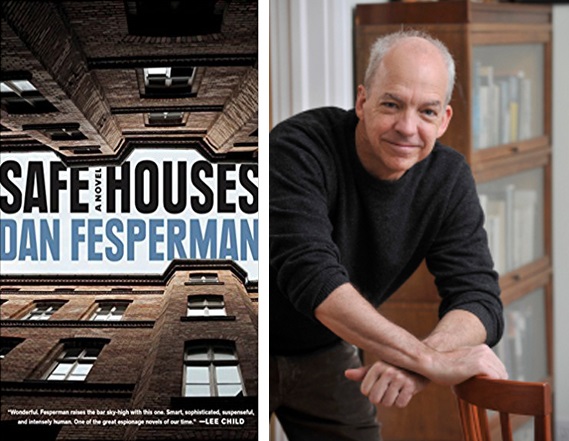
You know that feeling when a really great book creeps up on you out of nowhere and quickly becomes one of your very favorite novels in quite some time? Well, if you don’t, there’s a solid chance you’ll know exactly what I’m talking about after you read Dan Fesperman’s latest thriller, Safe Houses.
Admittedly, I don’t usually like books that shift between the past and present tense. I often prefer a more linear story that takes place over the course of a set period of time that I get to experience with the characters on the page. Every once in a while, though, a book comes along that makes me change my mind and appreciate the time jump, if it’s done correctly, because it can absolutely enrich the universe and the shifting storylines. Fesperman, with his latest novel, puts on a clinic, and other authors should take note of how he slowly rolls out the plot, characters, and conflict in Safe Houses, a magnificent spy thriller that checks off every box and then some.
Read a brief Q&A I did with Fesperman, who graciously agreed to go on the record for our Five Questions segment, then make sure to order your copy of Safe Houses, available everywhere on July 3, 2018.
TRBS: Lee Child called Safe Houses “one of the great espionage novels of our time,” and I couldn’t agree more. . . this book is amazing! How did you come up with the plot idea, and how much research did you have to do before actually sitting down to write?
Fesperman: “With most of my books it’s easy to pin down a single moment of inspiration. This one was more of a gradual coming together of a lot of seemingly unrelated pieces.
“As I told someone the other day, it was sort of like one of those evenings when it’s time to make dinner and you haven’t been to the store, so you take a gander inside the fridge to see what’s available and hope you can come up with something flavorful. One of the first ingredients I spotted was an old news account about the discovery of the archives of The Pond, an obscure spy organization that I’d never heard of until then. So I threw that into the pot. I also came across a wire story about a CIA station chief in Africa who’d been accused of multiple rapes. This made me think about positions of power and trust, and how they could be so easily abused in an intelligence organization.
“That, in turn, made me think of the vulnerable position of women case officers and agents, which took me back to some notes from a long-ago research interview I’d done with Betty McIntosh, a woman who’d worked for both the OSS and CIA. From there it all began to come together organically, and my research branched out along two main tracks – the experience of women in the CIA, circa 1979, and the strange and weird history of The Pond, particularly with regard to how it was eventually shut down, and then seemingly receded into history.”
TRBS: What is your writing process like? Do you outline your books, write at the same time each day, etc., and what advice do you have for aspiring authors?
Fesperman: “I do my best work in the morning before my mind starts getting cluttered, and the further I get into a manuscript the longer my writing day seems to extend. By the final chapters I’m often putting in six days a week, and writing or rewriting for six, seven hours a day. I suppose this is partly to make up for the agonizing pace I keep when I’m first getting started, groping for plot and character and a few unifying themes, and while still trying to do some research. I outline from time to time, but the degree of outlining is different with every book.
“My advice to any would-be writer is to simply write – as often as possible, for as long as possible, even if at first you hate the stuff you’re putting onto the page. You have to make it habitual, something that you can’t get through your day without doing, or else you’ll never develop the resolve to keep going.”
TRBS: Safe Houses reads like it would be perfect for the big screen. Is there a chance fans might one day see this adapted for film, and who would your dream casting choices be for some of the main characters?
Fesperman: “Well that would certainly be fun, but at this point, there have been no nibbles, so we’ll wait and see. Casting? I’m terrible at that kind of thing, but the two most important decisions would be to pick who would play Helen Abell and Claire Saylor, in the Berlin-Paris sequence set in 1979.
“My favorites are Amy Adams and Laura Linney, but they’d be too old for those roles – both characters are in their early- to mid-twenties – so I guess I’d settle for Jennifer Lawrence (hey, who wouldn’t?) as either Helen or Claire, because she’d be great at projecting just the right edge of attitude. To play Henry Mattick in the present-day sequence, maybe Ryan Gosling? Although he’s probably a little too old as well, so I guess I’ve struck out as a casting director.”
TRBS: What are some of your all-time favorite spy novels, and which books are currently sitting on your nightstand?
Fesperman: “John le Carre’s Tinker, Tailor, Soldier, Spy will always be the standard bearer for me, for its multi-layered complexities and its wonderful cast of characters, led by the great George Smiley. I’m also a big fan of the work of Charles Cumming and Chris Pavone, and I was recently wowed by Karen Cleveland’s outstanding debut, Need to Know, so all of her books will be on the nightstand from here on out.”
TRBS: Lastly, now that Safe Houses is set to hit bookstores, what’s next for you?
Fesperman: “I’m trying something that I haven’t done since my first two books, which featured the same main character. I’m reactivating Claire Saylor from Paris station to be the lead in the next one, which will be set in Hamburg in 1999, two decades after we first met her in Safe Houses. She’s great company, so I hope she’ll be around for a few more books.”
Praised as “one of today’s finest book reviewers” by New York Times bestselling author Gayle Lynds, Ryan Steck (“The Godfather of the thriller genre” — Ben Coes) has “quickly established himself as the authority on mysteries and thrillers” (Author A.J. Tata). He currently lives in Southwest Michigan with his wife and their six children.
